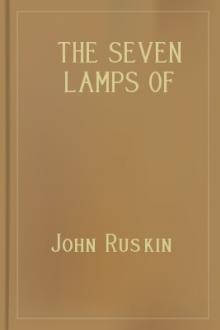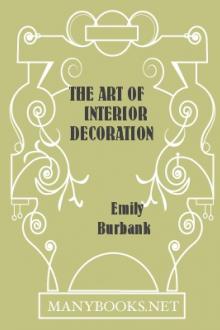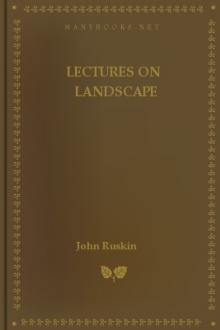The Seven Lamps of Architecture by John Ruskin (books like harry potter TXT) 📕

- Author: John Ruskin
- Performer: -
Book online «The Seven Lamps of Architecture by John Ruskin (books like harry potter TXT) 📕». Author John Ruskin
XL. Restraining ourselves, therefore, to the use of such simple patterns, so far forth as our color is subordinate either to architectural structure, or sculptural form, we have yet one more manner of ornamentation to add to our general means of effect, monochrome design, the intermediate condition between coloring and carving. The relations of the entire system of architectural decoration may then be thus expressed.
1. Organic form dominant. True, independent sculpture, and alto-relievo; rich capitals, and mouldings; to be elaborate in completion of form, not abstract, and either to be left in pure white marble, or most cautiously touched with color in points and borders only, in a system not concurrent with their forms.
2. Organic form sub-dominant. Basso-relievo or intaglio. To be more abstract in proportion to the reduction of depth; to be also more rigid and simple in contour; to be touched with color more boldly and in an increased degree, exactly in proportion to the reduced depth and fulness of form, but still in a system non-concurrent with their forms.
3. Organic form abstracted to outline. Monochrome design, still farther reduced to simplicity of contour, and therefore admitting for the first time the color to be concurrent with its outlines; that is to say, as its name imports, the entire figure to be detached in one color from a ground of another.
4. Organic forms entirely lost. Geometrical patterns or variable cloudings in the most vivid color.
On the opposite side of this scale, ascending from the color pattern, I would place the various forms of painting which may be associated with architecture: primarily, and as most fit for such purpose, the mosaic, highly abstract in treatment, and introducing brilliant color in masses; the Madonna of Torcello being, as I think, the noblest type of the manner, and the Baptistery of Parma the richest: next, the purely decorative fresco, like that of the Arena Chapel; finally, the fresco becoming principal, as in the Vatican and Sistine. But I cannot, with any safety, follow the principles of abstraction in this pictorial ornament; since the noblest examples of it appear to me to owe their architectural applicability to their archaic manner; and I think that the abstraction and admirable simplicity which render them fit media of the most splendid coloring, cannot be recovered by a voluntary condescension. The Byzantines themselves would not, I think, if they could have drawn the figure better, have used it for a color decoration; and that use, as peculiar to a condition of childhood, however noble and full of promise, cannot be included among those modes of adornment which are now legitimate or even possible. There is a difficulty in the management of the painted window for the same reason, which has not yet been met, and we must conquer that first, before we can venture to consider the wall as a painted window on a large scale. Pictorial subject, without such abstraction, becomes necessarily principal, or, at all events, ceases to be the architect's concern; its plan must be left to the painter after the completion of the building, as in the works of Veronese and Giorgione on the palaces of Venice.
XLI. Pure architectural decoration, then, may be considered as limited to the four kinds above specified; of which each glides almost imperceptibly into the other. Thus, the Elgin frieze is a monochrome in a state of transition to sculpture, retaining, as I think, the half-cast skin too long. Of pure monochrome, I have given an example in Plate VI., from the noble front of St. Michele of Lucca. It contains forty such arches, all covered with equally elaborate ornaments, entirely drawn by cutting out their ground to about the depth of an inch in the flat white marble, and filling the spaces with pieces of green serpentine; a most elaborate mode of sculpture, requiring excessive care and precision in the fitting of the edges, and of course double work, the same line needing to be cut both in the marble and serpentine. The excessive simplicity of the forms will be at once perceived; the eyes of the figures of animals, for instance, being indicated only by a round dot, formed by a little inlet circle of serpentine, about half an inch over: but, though simple, they admit often much grace of curvature, as in the neck of the bird seen above the right hand pillar.14 The pieces of serpentine have fallen out in many places, giving the black shadows, as seen under the horseman's arm and bird's neck, and in the semi-circular line round the arch, once filled with some pattern. It would have illustrated my point better to have restored the lost portions, but I always draw a thing exactly as it is, hating restoration of any kind; and I would especially direct the reader's attention to the completion of the forms in the sculptured ornament of the marble cornices, as opposed to the abstraction of the monochrome figures, of the ball and cross patterns between the arches, and of the triangular ornament round the arch on the left.
XLII. I have an intense love for these monochrome figures, owing to their wonderful life and spirit in all the works on which I found them; nevertheless, I believe that the excessive degree of abstraction which they imply necessitates our placing them in the rank of a progressive or imperfect art, and that a perfect building should rather be composed of the highest sculpture (organic form dominant and sub-dominant), associated with pattern colors on the flat or broad surfaces. And we find, in fact, that the cathedral of Pisa, which is a higher type than that of Lucca, exactly follows this condition, the color being put in geometrical patterns on its surfaces, and animal-forms and lovely leafage used in the sculptured cornices and pillars. And I think that the grace of the carved forms is best seen when it is thus boldly opposed to severe traceries of color, while the color itself is, as we have seen, always most piquant when it is put into sharp angular arrangements. Thus the sculpture is approved and set off by the color, and the color seen to the best advantage in its opposition both to the whiteness and the grace of the carved marble.
XLIII. In the course of this and the preceding chapters, I have now separately enumerated most of the conditions of Power and Beauty, which in the outset I stated to be the grounds of the deepest impressions with which architecture could affect the human mind; but I would ask permission to recapitulate them in order to see if there be any building which I may offer as an example of the unison, in such manner as is possible, of them all. Glancing back, then, to the beginning of the third chapter, and introducing in their place the conditions incidentally determined in the two previous sections, we shall have the following list of noble characters:
Considerable size, exhibited by simple terminal lines (Chap. III. § 6). Projection towards the top (§ 7). Breadth of flat surface (§ 8). Square compartments of that surface (§ 9). Varied and visible masonry (§ 11). Vigorous depth of shadow (§ 13), exhibited especially by pierced traceries (§ 18). Varied proportion in ascent (Chap. IV. § 28). Lateral symmetry (§ 28). Sculpture most delicate at the base (Chap. I. § 12). Enriched quantity of ornament at the top (§ 13). Sculpture abstract in inferior ornaments and mouldings (Chap. IV. § 31), complete in animal forms (§ 33). Both to be executed in white marble (§ 40). Vivid color introduced in flat geometrical patterns (§ 39), and obtained by the use of naturally colored stone (§ 35).
These characteristics occur more or less in different buildings, some in one and some in another. But all together, and all in their highest possible relative degrees, they exist, as far as I know, only in one building in the world, the Campanile of Giotto at Florence. The drawing of the





Comments (0)